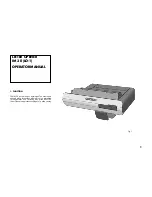
4
BATTERIES
16
6.
Test each cell and note the readings (corrected to
80
°
F or 27
°
C). A variation of fifty points between
any two cell readings (example 1.250 - 1.200)
indicates a problem with the low reading cell(s).
7.
As a battery ages the specific gravity of the
electrolyte will decrease at full charge. This is not a
reason to replace the battery, providing all cells are
within fifty points of each other.
8.
Since the hydrometer test is in response to a vehicle
exhibiting
a
performance
problem,
the
vehicle
should be recharged and the test repeated. If the
results indicate a weak cell, the battery or batteries
should be removed and replace with one of the
same brand, type and approximate age that is
known to be good.
Temperature Correction for Hydrometer Readings
Figure 4N
32
28
24
20
16
12
8
4
0
4
8
12
16
20
24
28
32
36
32
28
24
20
16
12
8
4
0
4
8
12
16
20
24
28
32
36
1100
1125
1150
1200
1225
1250
1275
1300
1100
1125
1150
1200
1225
1250
1275
1300
1175
160
71.1
+32
150
65.6
+28
140
60.0
+24
130
54.4
+20
120
48,9
+16
110
43.3
+12
100
37.8
+8
90
32.2
+4
80
26.7
0
70
21.1
–4
60
15.6
–8
50
10
–12
40
4.4
–16
30
–1.1
–20
20
–6.7
–24
10
–12.1 –28
°
F
°
C
ADD TO FLOAT
READING
SUBTRACT
FROM FLOAT
READING
A
B
C
D
EXAMPLE 1
Temperature above 80
°
F (26.7
°
C)
Hydrometer reading 1.240
Electrolyte temperature 110
°
F (43.3
°
C)
110
°
F - 80
°
F = 30
°
F, 3 x .004 = .012
1.240 + .012 = 1.252
corrected specific gravity reading
EXAMPLE 2
Temperature below 80
°
F (26.7
°
C)
Hydrometer reading 1.270
Electrolyte temperature 30
°
F (43.3
°
C)
80
°
F - 30
°
F = 50
°
F, 5 x .004 = .020
1.270 - .020 = 1.250
corrected specific gravity reading
E
TR010
















































